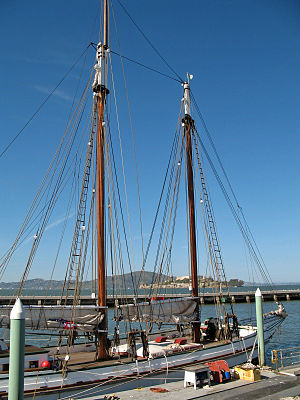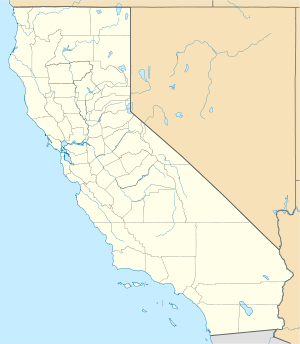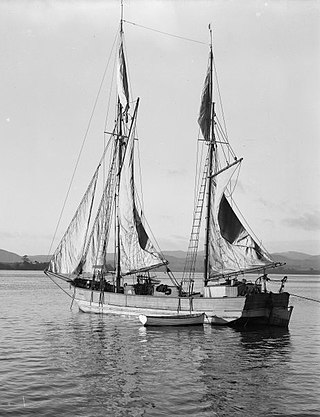
A scow is a smaller type of barge. Some scows are rigged as sailing scows. In the 19th and early 20th centuries, scows carried cargo in coastal waters and inland waterways, having an advantage for navigating shallow water or small harbours. Scows were in common use in the American Great Lakes and other parts of the U.S., Canada, southern England, and New Zealand. In modern times their main purpose is for recreation and racing.
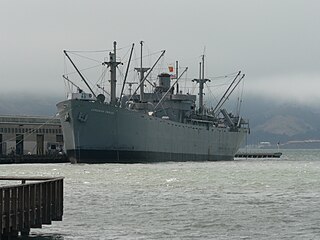
SS Jeremiah O'Brien is a Liberty ship built during World War II and named after the American Revolutionary War ship captain Jeremiah O'Brien (1744–1818).

Balclutha, also known as Star of Alaska, Pacific Queen, or Sailing Ship Balclutha, is a steel-hulled full-rigged ship that was built in 1886. She is representative of several different commercial ventures, including lumber, salmon, and grain. She is a U.S. National Historic Landmark and is currently preserved at the San Francisco Maritime National Historical Park in San Francisco, California. She was added to the National Register of Historic Places on 7 November 1976.

The San Francisco Maritime National Historical Park is located in San Francisco, California, United States. The park includes a fleet of historic vessels, a visitor center, a maritime museum, and a library/research facility. Formerly referred to as the San Francisco Maritime Museum, the collections were acquired by the National Park Service in 1978. The San Francisco Maritime National Historical Park was authorized in 1988; the maritime museum is among the park's many cultural resources. The park also incorporates the Aquatic Park Historic District, bounded by Van Ness Avenue, Polk Street, and Hyde Street.

C.A. Thayer is a schooner built in 1895 near Eureka, California. The schooner has been preserved and open to the public at the San Francisco Maritime National Historical Park since 1963. She is one of the last survivors of the sailing schooners in the West coast lumber trade to San Francisco from Washington, Oregon, and Northern California. She was designated a National Historic Landmark on 13 November 1966.

Eureka is a side-wheel paddle steamboat, built in 1890, which is now preserved at the San Francisco Maritime National Historical Park in San Francisco, California. Originally named Ukiah to commemorate the railway's recent extension into the City of Ukiah, the boat was built by the San Francisco and North Pacific Railroad Company at their Tiburon yard. Eureka has been designated a National Historic Landmark and was listed in the National Register of Historic Places on April 24, 1973.
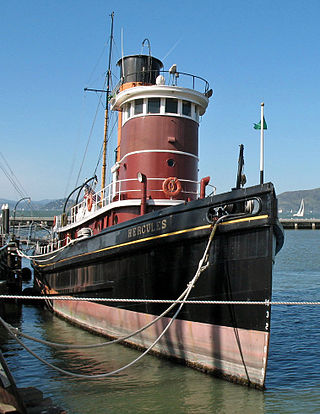
Hercules is a 1907-built steam tugboat that is now preserved at the San Francisco Maritime National Historical Park in San Francisco, California.

The tall ship Elissa is a three-masted barque. She is based in Galveston, Texas, and is one of the oldest ships sailing today. Launched in 1877, she is now a museum ship at the Texas Seaport Museum. She was designated a National Historic Landmark in 1990. The Texas Legislature designated Elissa the official tall ship of Texas in 2005.
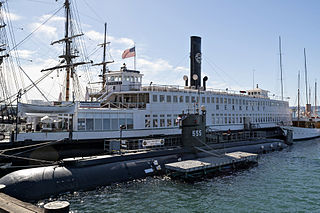
Berkeley was one of several ferryboats of the Southern Pacific Railroad that for sixty years operated on San Francisco Bay between the Oakland Pier and the San Francisco Ferry Building. Built in 1898 by the Union Iron Works of San Francisco, she served after the 1906 earthquake, ferrying refugees across the bay to Oakland.

Effie M. Morrissey is a schooner skippered by Robert Bartlett that made many scientific expeditions to the Arctic, sponsored by American museums, the Explorers Club and the National Geographic Society. She also helped survey the Arctic for the United States Government during World War II. She is currently designated by the United States Department of the Interior as a National Historic Landmark as part of the New Bedford Whaling National Historical Park. She is the State Ship of Massachusetts.

Wawona was an American three-masted, fore-and-aft schooner that sailed from 1897 to 1947 as a lumber carrier and fishing vessel based in Puget Sound. She was one of the last survivors of the sailing schooners in the West Coast lumber trade to San Francisco from Washington, Oregon, and Northern California.

Aquatic Park Historic District is a National Historic Landmark and building complex on the San Francisco Bay waterfront within San Francisco Maritime National Historical Park.

James Preston Delgado is a maritime archaeologist, historian, maritime preservation expert, author, television host, and explorer.

Adventuress is a 133-foot (41 m) gaff-rigged schooner launched in 1913 in East Boothbay, Maine. She has since been restored, and is listed as a National Historic Landmark. She is one of two surviving San Francisco bar pilot schooners.

Governor Stone is a historic schooner, built in 1877, in Pascagoula, Mississippi, United States. She is the only surviving two-masted coasting cargo schooner built on the Gulf Coast of the United States, and is only one of five such surviving US-built ships. On 4 December 1991, she was added to the US National Register of Historic Places. One year later, the schooner was designated a US National Historic Landmark. She is presently berthed at Saint Andrews Marina in Panama City, Florida, where she is maintained by a nonprofit group. Sailing tours are regularly scheduled.

Bowdoin is a historic schooner built in 1921 in East Boothbay, Maine, at the Hodgdon Brothers Shipyard. Designed by William H. Hand, Jr. under the direction of explorer Donald B. MacMillan, the gaff-rigged vessel is the only American schooner built specifically for Arctic exploration. She has made 29 trips above the Arctic Circle in her life, three since she was acquired by the Maine Maritime Academy as a sail training ship in 1988. She is currently owned by the Academy, located in Castine, Maine, and is named for Bowdoin College.

Lettie G. Howard, formerly Mystic C and Caviare, is a wooden Fredonia schooner built in 1893 in Essex, Massachusetts, USA. This type of craft was commonly used by American offshore fishermen, and is believed to be the last surviving example of its type. She was declared a National Historic Landmark in 1989. She is now based at the South Street Seaport Museum in New York City.
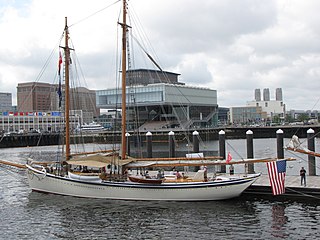
The American Eagle, originally Andrew and Rosalie, is a two-masted schooner serving the tourist trade out of Rockland, Maine. Launched in 1930 at Gloucester, Massachusetts, she was the last auxiliary schooner to be built in that port, and one of Gloucester's last sail-powered fishing vessels. A National Historic Landmark, she is also the oldest known surviving vessel of the type, which was supplanted not long afterward by modern trawlers.

Lewis R. French is a gaff-rigged topsail schooner sailing out of Camden, Maine as a "Maine windjammer" offering 3 to 6 night cruises to tourists. Built in 1871, she is the oldest known two-masted schooner in the United States, and one of a small number of this once-common form of vessel in active service. The ship was designated a US National Historic Landmark in 1992.
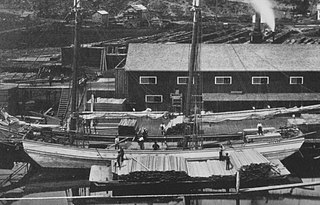
The Mayflower was a wooden hulled scow-schooner that sank on June 2, 1891, in Lake Superior near Duluth, Minnesota, United States, after capsizing with a load of sandstone blocks. In 2012 the shipwreck site was added to the National Register of Historic Places.

